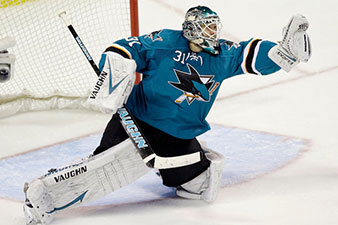
04/02/2014 12:34
Finnish Soul Is Reflected in Goalies
The duel at 178 feet between Antti Niemi and Tuukka Rask took place last month in California, with the fateful shot heard halfway around the world in Finland, long known for skiing, saunas, sunless winters and smartphones, and increasingly gaining notice for its puck stoppers.
Beginning with Markus Mattsson in 1980, Finland, a country of 5.41 million people, has produced more N.H.L. goalies than any other European country, according to the league. The 30-team N.H.L. contains eight goaltenders from Finland, including four regular starters. The only countries with more are Canada (29), the United States (14) and Sweden (12). With more puck stoppers in their pipeline than vowels in their names, the Finns have the luxury of rolling goaltenders in the Olympics the way coaches do forward lines during a game.
At the Sochi Games, Finland will be represented by Niemi of the San Jose Sharks, Rask of the Boston Bruins and Kari Lehtonen of the Dallas Stars, succeeding Miikka Kiprusoff, Niklas Backstrom and Antero Niittymaki, members of the bronze medal team four years ago.
Since the 2010 Vancouver Games, Niemi and Rask have played for a Stanley Cup, with Niemi becoming the first goaltender from his country to lift it. Rask, 26, entered Monday leading the league this season in shutouts; Niemi, 30, was tied for second in wins. They are performing well enough to make people forget about the 31-year-old Pekka Rinne, a two-time Vezina Trophy finalist for the Nashville Predators who has been sidelined with a hip injury since October.
When the Bruins eked out a 1-0 victory in San Jose on Jan. 11, Rask and Niemi were the best players on the ice in what felt like an Olympic save-off. Finland, Canada and United States are the only Olympic teams taking three starting N.H.L. goalies to Sochi.
“Obviously, every coach’s dream is to have so many strong goalies that you almost have a problem of who to pick,” said Teemu Selanne, a Finnish forward heading to his sixth Olympics and the leading scorer in men’s hockey in the Winter Games. “It has been a good problem for us for a long time.”
There is no end in sight. The women’s Olympic team is led by Noora Raty, a former University of Minnesota star who is in her third Olympics at age 24. At the recent world junior championships, Juuse Saros, 18, backstopped Finland to the gold medal, posting a tournament-leading 1.57 goals-against average and a .943 save percentage in six games.
Asked if there is something in the Finnish character to explain the country’s goaltending success, Saros, a fourth-round draft pick of Nashville last year, said, “Maybe it’s the tendency we have to try and do everything we do very attentively and accurately.”
Finnish success in N.H.L. nets is often traced to Kiprusoff, a 1995 fifth-round draft pick by the Sharks who is the most well-known of the Flopping Finns. Kiprusoff, who retired last year at 37, led the Calgary Flames to the Stanley Cup finals in 2004 and won the Vezina Trophy the next season. He is the winningest Finnish goalie in the N.H.L., with 319 victories in 623 games.
But Finland’s goal rush started well before the discovery of Kiprusoff. In 1970, six years before Kiprusoff was born, Urpo Ylonen was named the best goaltender at the world championships. Eight years later, at the European junior championships, Jari Paavola won the tournament’s goaltending award but was upstaged by his teammate Jari Kurri, who delivered the decisive goal in an upset of the Soviet Union in the final. Jorma Valtonen’s international career included a start in the 1980 Olympic gold medal game against the United States squad that was coming off its “Miracle on Ice” victory against the Soviet Union.
Until the end of the 1970s, the N.H.L.’s eyes were for North American players only. European players popped up on the league’s radar during international events, only to disappear until the next one. In the 1980s, Kurri and defenseman Esa Tikkanen, part of a trend that started with the renegade World Hockey Association, opened the Finnish channel to North America by becoming key contributors on the Edmonton Oilers’ championship teams.
When the current Finnish goaltenders talk about the trailblazers who made it possible for them to dream of an N.H.L. career, they speak of Mattsson, Jarmo Myllys and Kari Takko, who logged a combined 273 games in the league from 1980 to 1992.
“I’m sure it wasn’t easy for those guys,” Lehtonen said, “because the norm then was you have Canadian goalies and that’s it.”
Lots of Groundwork
After an hourlong practice at Chelsea Piers during a trip to New York last month, Lehtonen, 30, was stopped by two men, the only Dallas player to be approached by the gaggle of fans that had gathered there. Tourists from Finland, they asked him if he would pose for a photograph, which he did wearing an embarrassed expression.
At 19, Lehtonen was taken second over all by the Atlanta Thrashers in the 2002 draft. It was the highest a European goaltender had been selected, 19 places better than the previous high, established in 1994 by Evgeni Ryabchikov of Russia and equaled in 1997 by Lehtonen’s countryman Mika Noronen.








